2018 NISSAN VERSA tires
[x] Cancel search: tiresPage 310 of 354
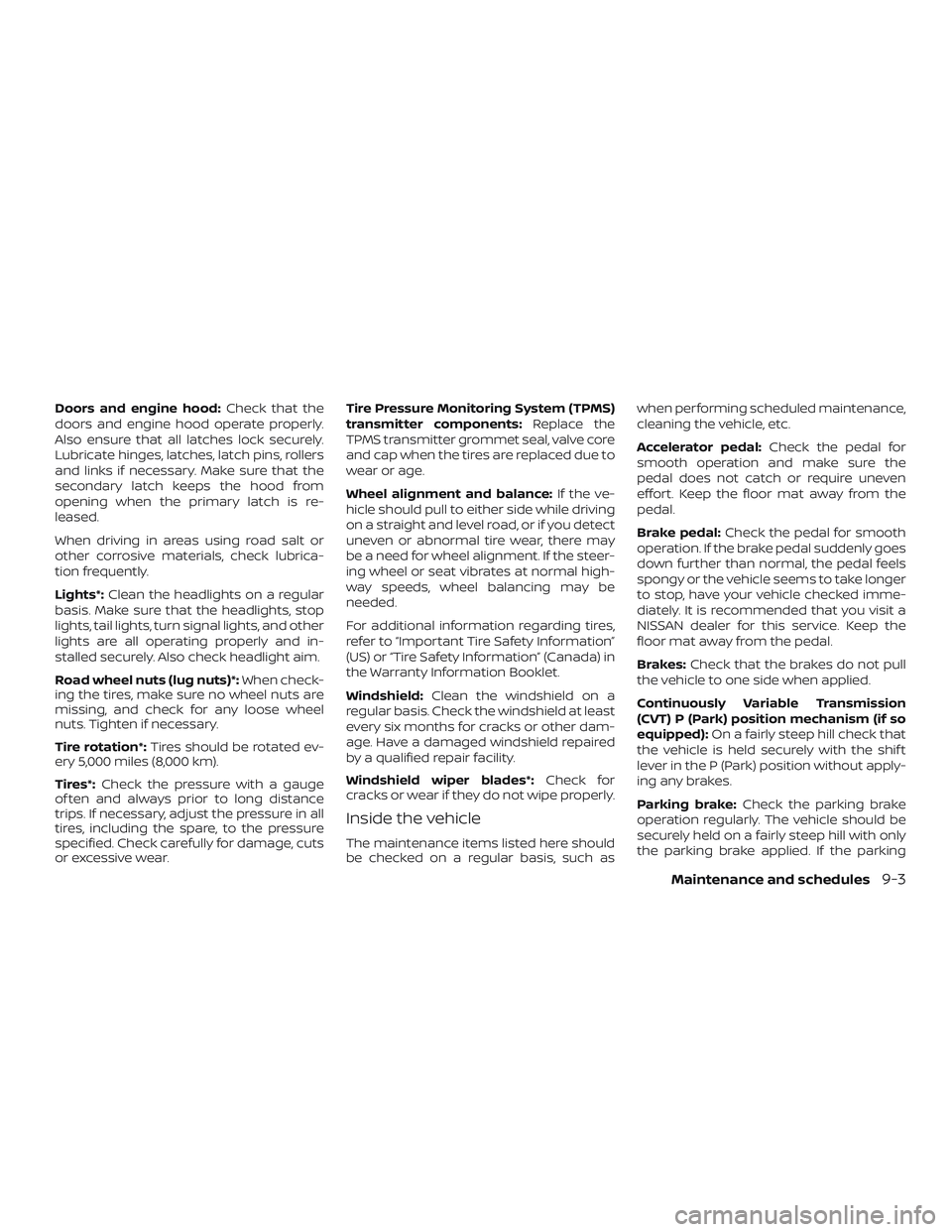
Doors and engine hood:Check that the
doors and engine hood operate properly.
Also ensure that all latches lock securely.
Lubricate hinges, latches, latch pins, rollers
and links if necessary. Make sure that the
secondary latch keeps the hood from
opening when the primary latch is re-
leased.
When driving in areas using road salt or
other corrosive materials, check lubrica-
tion frequently.
Lights*:Clean the headlights on a regular
basis. Make sure that the headlights, stop
lights, tail lights, turn signal lights, and other
lights are all operating properly and in-
stalled securely. Also check headlight aim.
Road wheel nuts (lug nuts)*:When check-
ing the tires, make sure no wheel nuts are
missing, and check for any loose wheel
nuts. Tighten if necessary.
Tire rotation*:Tires should be rotated ev-
ery 5,000 miles (8,000 km).
Tires*:Check the pressure with a gauge
of ten and always prior to long distance
trips. If necessary, adjust the pressure in all
tires, including the spare, to the pressure
specified. Check carefully for damage, cuts
or excessive wear.Tire Pressure Monitoring System (TPMS)
transmitter components:Replace the
TPMS transmitter grommet seal, valve core
and cap when the tires are replaced due to
wear or age.
Wheel alignment and balance:If the ve-
hicle should pull to either side while driving
on a straight and level road, or if you detect
uneven or abnormal tire wear, there may
be a need for wheel alignment. If the steer-
ing wheel or seat vibrates at normal high-
way speeds, wheel balancing may be
needed.
For additional information regarding tires,
refer to “Important Tire Safety Information”
(US) or “Tire Safety Information” (Canada) in
the Warranty Information Booklet.
Windshield:Clean the windshield on a
regular basis. Check the windshield at least
every six months for cracks or other dam-
age. Have a damaged windshield repaired
by a qualified repair facility.
Windshield wiper blades*:Check for
cracks or wear if they do not wipe properly.
Inside the vehicle
The maintenance items listed here should
be checked on a regular basis, such aswhen performing scheduled maintenance,
cleaning the vehicle, etc.
Accelerator pedal:Check the pedal for
smooth operation and make sure the
pedal does not catch or require uneven
effort. Keep the floor mat away from the
pedal.
Brake pedal:Check the pedal for smooth
operation. If the brake pedal suddenly goes
down further than normal, the pedal feels
spongy or the vehicle seems to take longer
to stop, have your vehicle checked imme-
diately. It is recommended that you visit a
NISSAN dealer for this service. Keep the
floor mat away from the pedal.
Brakes:Check that the brakes do not pull
the vehicle to one side when applied.
Continuously Variable Transmission
(CVT) P (Park) position mechanism (if so
equipped):On a fairly steep hill check that
the vehicle is held securely with the shif t
lever in the P (Park) position without apply-
ing any brakes.
Parking brake:Check the parking brake
operation regularly. The vehicle should be
securely held on a fairly steep hill with only
the parking brake applied. If the parking
Maintenance and schedules9-3
Page 313 of 354

Engine coolant*:Replace coolant at the
specified interval. When adding or replac-
ing coolant, be sure to use only Genuine
NISSAN Long Life Antifreeze/Coolant (blue)
or equivalent with the proper mixture. (For
additional information on the proper mix-
ture for your area, refer to “Engine cooling
system” in the “Do-it-yourself ” section of
this manual.)
NOTE: Mixing any other type of coolant
or the use of non-distilled water may re-
duce the recommended service interval
of the coolant.
Engine oil and oil filter:Replace engine oil
and oil filter at the specified intervals. For
recommended oil grade and viscosity refer
to “Recommended fluids/lubricants and
capacities” in the “Technical and consumer
information” section of this manual.
Fuel lines*:Check the fuel hoses, piping
and connections for leaks, looseness, or
deterioration. Tighten connections or re-
place parts as necessary.
Spark plugs:Replace at specified intervals.
Install new plugs of the type as originally
equipped.CHASSIS AND BODY
MAINTENANCE:
Brake lines and cables:Visually inspect for
proper installation. Check for chafing,
cracks, deterioration, and signs of leaking.
Replace any deteriorated or damaged
parts immediately.
Brake pads, rotors, drums and linings:
Check for wear, deterioration and fluid
leaks. Replace any deteriorated or dam-
aged parts immediately.
Exhaust system:Visually inspect the ex-
haust pipes, muffler and hangers for leaks,
cracks, deterioration, and damage. Tighten
connections or replace parts as necessary.
Steering gear and linkage, axle and sus-
pension parts, drive shaf t boots:Check
for damage, looseness, and leakage of oil
or grease. Under severe driving conditions,
inspect more frequently.
Tire rotation:Tires should be rotated every
5,000 miles (8,000 km) according to the in-
structions under “General maintenance” in
this section. When rotating tires, check for
damage and uneven wear. Replace if nec-
essary.Transmission fluid/oil:Visually inspect for
signs of leakage at specified intervals.
If towing a trailer, using a camper or car-top
carrier, or driving on rough or muddy roads,
replace the CVT fluid every 60,000 miles
(96,000 km) or request the dealer to inspect
the fluid deterioration data using a CON-
SULT. If the deterioration data is more than
210000, replace the CVT fluid.
9-6Maintenance and schedules
Page 324 of 354
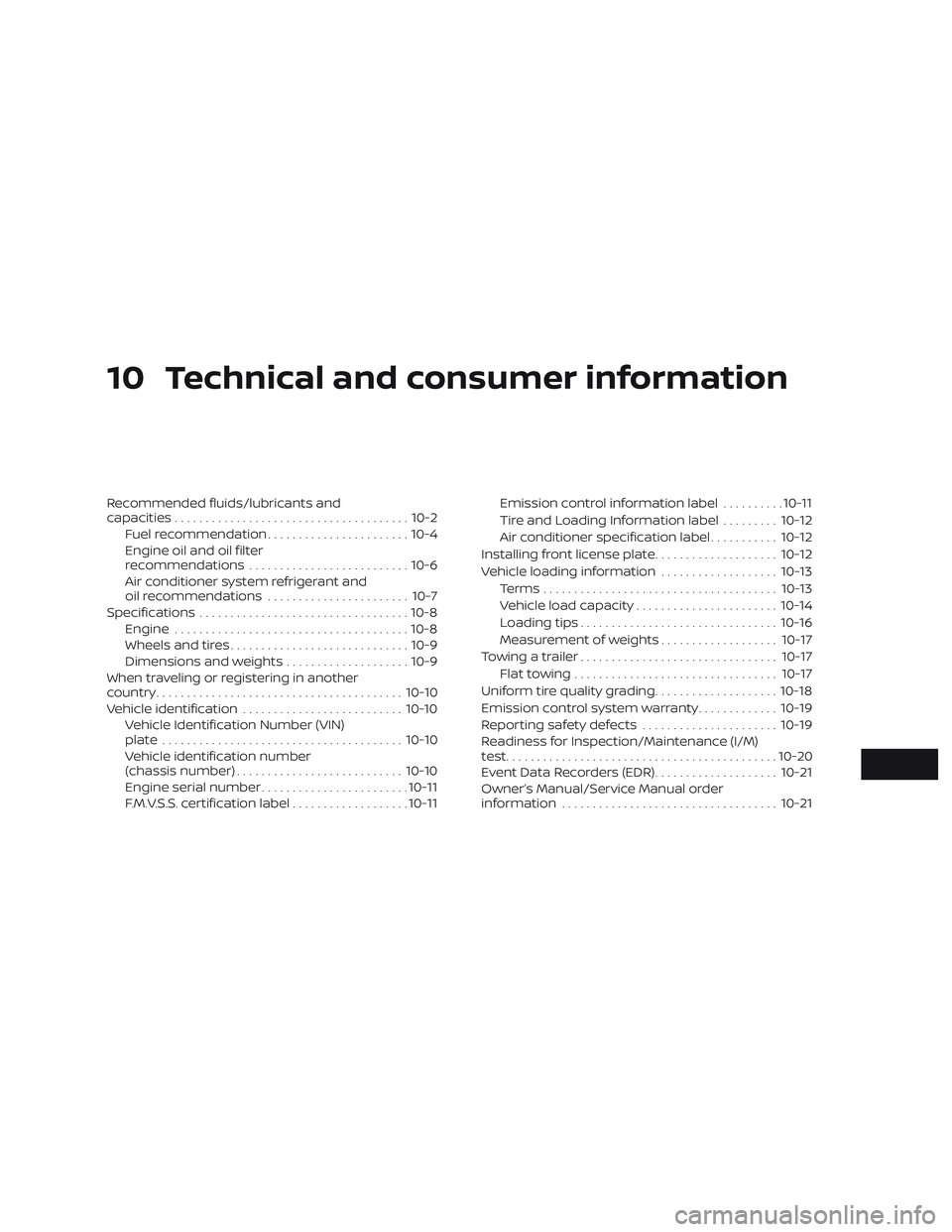
10 Technical and consumer information
Recommended fluids/lubricants and
capacities......................................10-2
Fuel recommendation.......................10-4
Engine oil and oil filter
recommendations..........................10-6
Air conditioner system refrigerant and
oil recommendations.......................10-7
Specifications..................................10-8
Engine......................................10-8
Wheels and tires.............................10-9
Dimensions and weights....................10-9
When traveling or registering in another
country........................................10-10
Vehicle identification..........................10-10
Vehicle Identification Number (VIN)
plate.......................................10-10
Vehicle identification number
(chassis number)...........................10-10
Engine serial number........................10-11
F.M.V.S.S. certification label...................10-11Emission control information label..........10-11
Tire and Loading Information label.........10-12
Air conditioner specification label...........10-12
Installing front license plate....................10-12
Vehicle loading information...................10-13
Terms......................................10-13
Vehicle load capacity.......................10-14
Loading tips................................10-16
Measurement of weights...................10-17
Towing a trailer................................10-17
Flat towing.................................10-17
Uniform tire quality grading....................10-18
Emission control system warranty.............10-19
Reporting safety defects......................10-19
Readiness for Inspection/Maintenance (I/M)
test............................................10-20
Event Data Recorders (EDR)....................10-21
Owner’s Manual/Service Manual order
information...................................10-21
Page 332 of 354
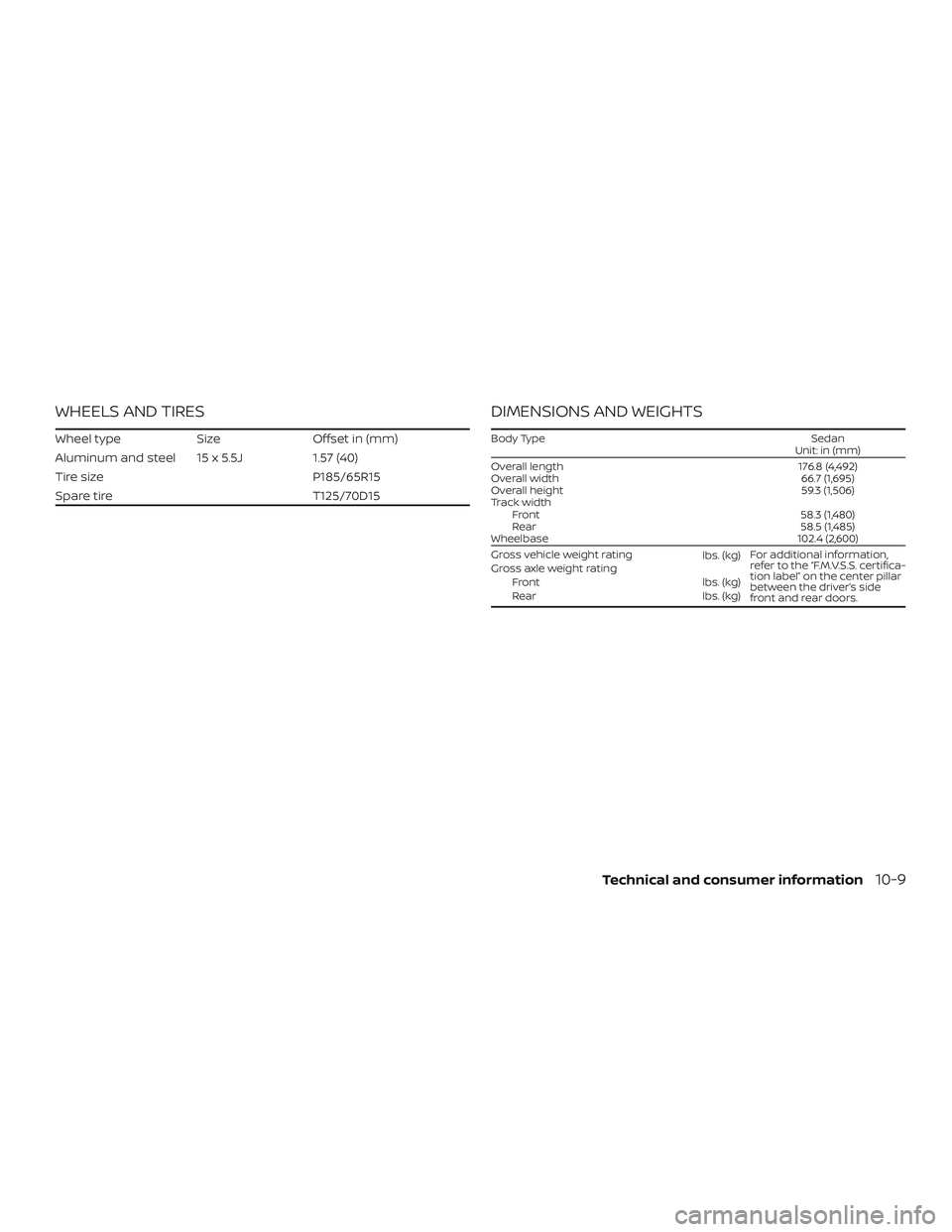
WHEELS AND TIRES
Wheel type Size Offset in (mm)
Aluminum and steel 15 x 5.5J 1.57 (40)
Tire size P185/65R15
Spare tire T125/70D15
DIMENSIONS AND WEIGHTS
Body Type Sedan
Unit: in (mm)
Overall length 176.8 (4,492)
Overall width 66.7 (1,695)
Overall height 59.3 (1,506)
Track width
Front 58.3 (1,480)
Rear 58.5 (1,485)
Wheelbase 102.4 (2,600)
Gross vehicle weight rating
lbs. (kg)For additional information,
refer to the “F.M.V.S.S. certifica-
tion label” on the center pillar
between the driver’s side
front and rear doors. Gross axle weight rating
Front lbs. (kg)
Rear lbs. (kg)
Technical and consumer information10-9
Page 339 of 354
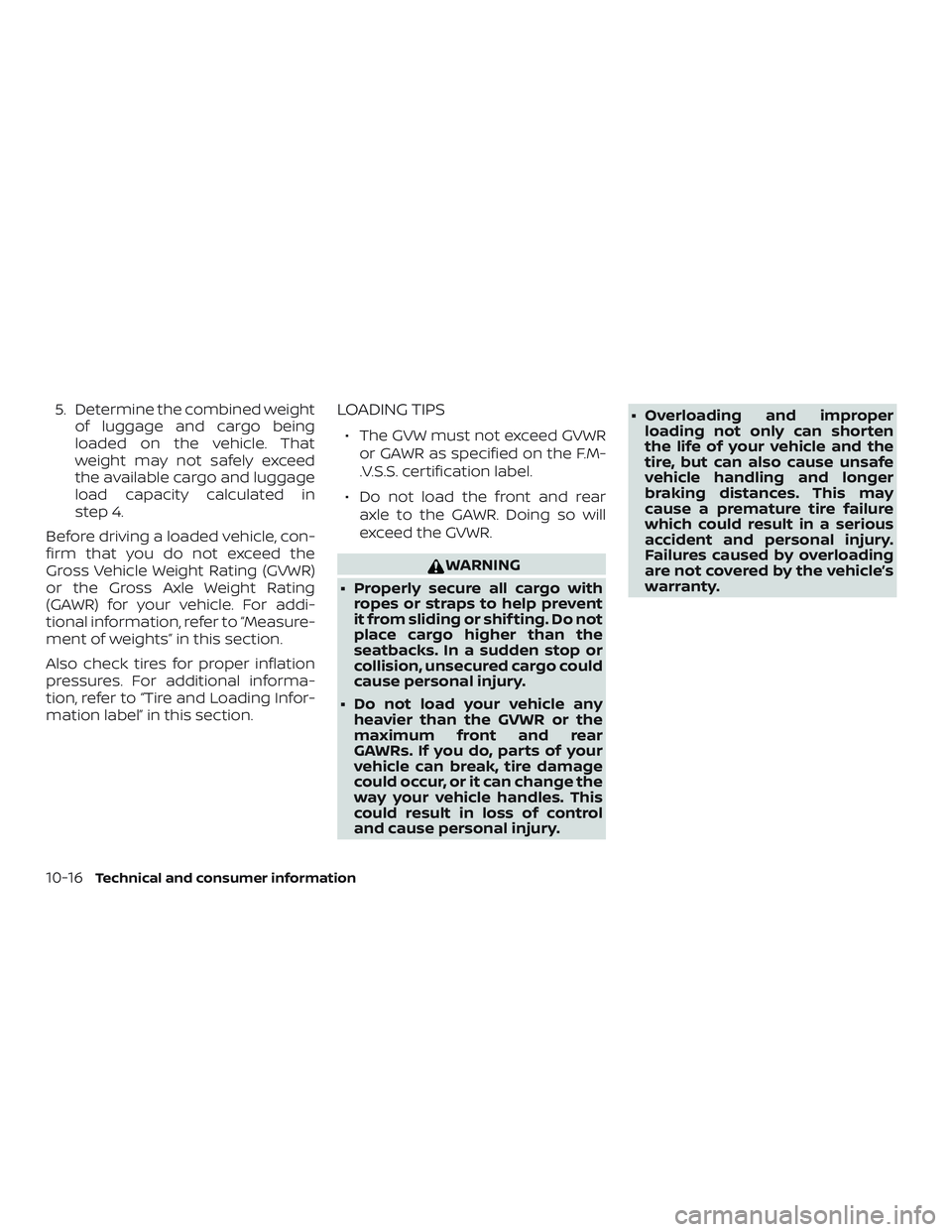
5. Determine the combined weight
of luggage and cargo being
loaded on the vehicle. That
weight may not safely exceed
the available cargo and luggage
load capacity calculated in
step 4.
Before driving a loaded vehicle, con-
firm that you do not exceed the
Gross Vehicle Weight Rating (GVWR)
or the Gross Axle Weight Rating
(GAWR) for your vehicle. For addi-
tional information, refer to “Measure-
ment of weights” in this section.
Also check tires for proper inflation
pressures. For additional informa-
tion, refer to “Tire and Loading Infor-
mation label” in this section.LOADING TIPS
∙ The GVW must not exceed GVWR
or GAWR as specified on the F.M-
.V.S.S. certification label.
∙ Do not load the front and rear
axle to the GAWR. Doing so will
exceed the GVWR.
WARNING
∙ Properly secure all cargo with
ropes or straps to help prevent
it from sliding or shif ting. Do not
place cargo higher than the
seatbacks. In a sudden stop or
collision, unsecured cargo could
cause personal injury.
∙ Do not load your vehicle any
heavier than the GVWR or the
maximum front and rear
GAWRs. If you do, parts of your
vehicle can break, tire damage
could occur, or it can change the
way your vehicle handles. This
could result in loss of control
and cause personal injury.∙ Overloading and improper
loading not only can shorten
the life of your vehicle and the
tire, but can also cause unsafe
vehicle handling and longer
braking distances. This may
cause a premature tire failure
which could result in a serious
accident and personal injury.
Failures caused by overloading
are not covered by the vehicle’s
warranty.
10-16
Technical and consumer information
Page 340 of 354
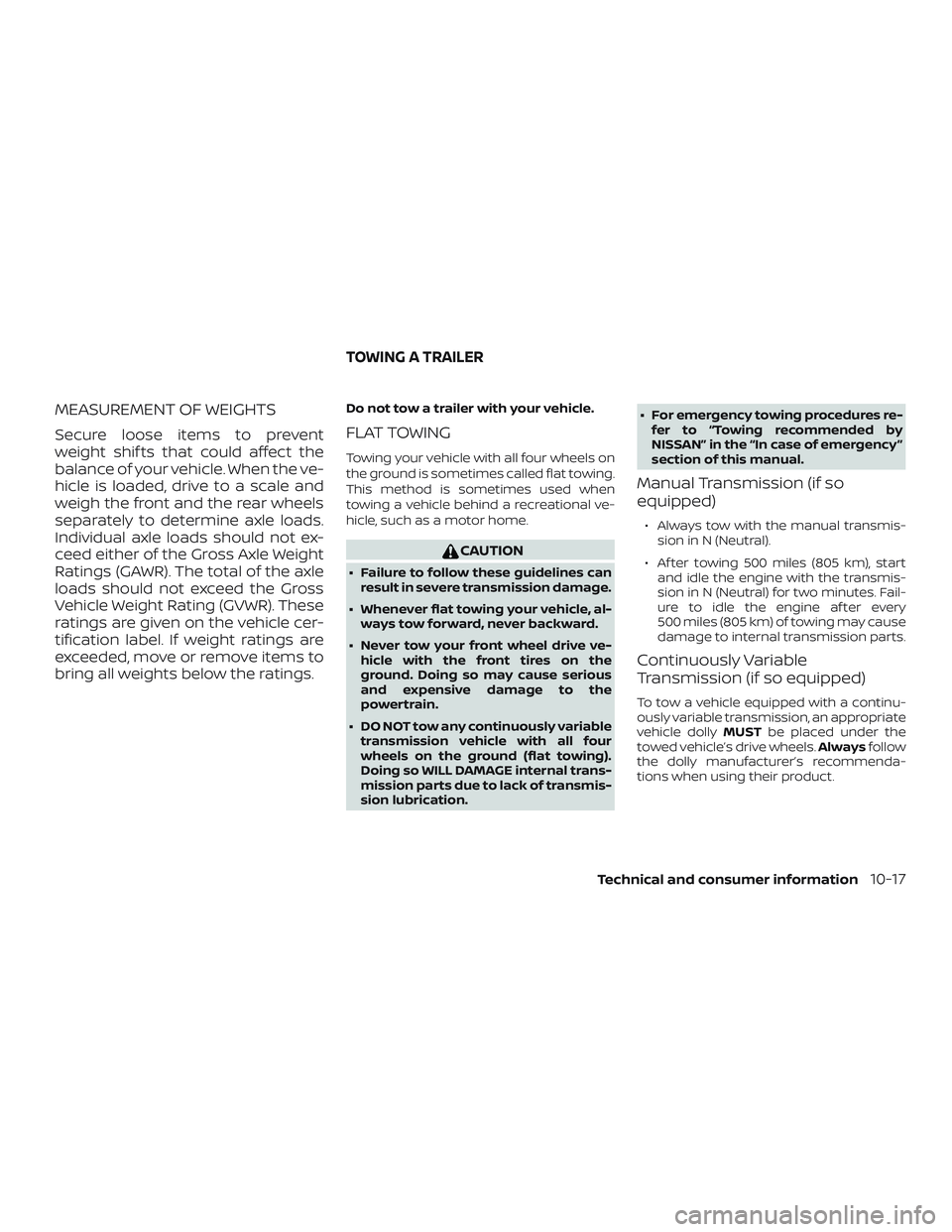
MEASUREMENT OF WEIGHTS
Secure loose items to prevent
weight shif ts that could affect the
balance of your vehicle. When the ve-
hicle is loaded, drive to a scale and
weigh the front and the rear wheels
separately to determine axle loads.
Individual axle loads should not ex-
ceed either of the Gross Axle Weight
Ratings (GAWR). The total of the axle
loads should not exceed the Gross
Vehicle Weight Rating (GVWR). These
ratings are given on the vehicle cer-
tification label. If weight ratings are
exceeded, move or remove items to
bring all weights below the ratings.
Do not tow a trailer with your vehicle.
FLAT TOWING
Towing your vehicle with all four wheels on
the ground is sometimes called flat towing.
This method is sometimes used when
towing a vehicle behind a recreational ve-
hicle, such as a motor home.
CAUTION
∙ Failure to follow these guidelines can
result in severe transmission damage.
∙ Whenever flat towing your vehicle, al-
ways tow forward, never backward.
∙ Never tow your front wheel drive ve-
hicle with the front tires on the
ground. Doing so may cause serious
and expensive damage to the
powertrain.
∙ DO NOT tow any continuously variable
transmission vehicle with all four
wheels on the ground (flat towing).
Doing so WILL DAMAGE internal trans-
mission parts due to lack of transmis-
sion lubrication.∙ For emergency towing procedures re-
fer to “Towing recommended by
NISSAN” in the “In case of emergency ”
section of this manual.
Manual Transmission (if so
equipped)
∙ Always tow with the manual transmis-
sion in N (Neutral).
∙ Af ter towing 500 miles (805 km), start
and idle the engine with the transmis-
sion in N (Neutral) for two minutes. Fail-
ure to idle the engine af ter every
500 miles (805 km) of towing may cause
damage to internal transmission parts.
Continuously Variable
Transmission (if so equipped)
To tow a vehicle equipped with a continu-
ously variable transmission, an appropriate
vehicle dollyMUSTbe placed under the
towed vehicle’s drive wheels.Alwaysfollow
the dolly manufacturer’s recommenda-
tions when using their product.
TOWING A TRAILER
Technical and consumer information10-17
Page 341 of 354

DOT (Department of Transportation) Qual-
ity Grades: All passenger car tires must
conform to federal safety requirements in
addition to these grades.
Quality grades can be found where appli-
cable on the tire sidewall between tread
shoulder and maximum section width. For
example:
Treadwear 200 Traction AA Temperature
A
Treadwear
The treadwear grade is a comparative rat-
ing based on the wear rate of the tire when
tested under controlled conditions on a
specified government test course. For ex-
ample, a tire graded 150 would wear one
and one-half (1 1/2) times as well on the
government course as a tire graded 100.
The relative performance of tires depends
upon the actual conditions of their use,
however, and may depart significantly from
the norm due to variations in driving habits,
service practices and differences in road
characteristics and climate.
Traction AA, A, B and C
The traction grades, from highest to low-
est, are AA, A, B, and C. Those grades repre-
sent the tire’s ability to stop on wet pave-ment as measured under controlled
conditions on specified government test
surfaces of asphalt and concrete. A tire
marked C may have poor traction perfor-
mance.
WARNING
The traction grade assigned to this tire
is based on straight-ahead braking
traction tests, and does not include ac-
celeration, cornering, hydroplaning, or
peak traction characteristics.
Temperature A, B and C
The temperature grades are A (the high-
est), B, and C, representing the tire’s resis-
tance to the generation of heat, and its
ability to dissipate heat when tested under
controlled conditions on a specified indoor
laboratory test wheel. Sustained high tem-
perature can cause the material of the tire
to degenerate and reduce tire life, and ex-
cessive temperature can lead to sudden
tire failure. The grade C corresponds to a
level of performance which all passenger
car tires must meet under the Federal Mo-
tor Safety Standard No. 109. Grades B and A
represent higher levels of performance on
the laboratory test wheel than the mini-
mum required by law.
WARNING
The temperature grade for this tire is
established for a tire that is properly in-
flated and not overloaded. Excessive
speed, under-inflation, or excessive
loading, either separately or in combi-
nation, can cause heat build-up and
possible tire failure.
UNIFORM TIRE QUALITY GRADING
10-18Technical and consumer information
Page 351 of 354

Precautions on supplemental restraint
system....................1-42
Supplemental restraint system
(Supplemental air bag system).......1-42
Switch
Automatic power window switch . . .2-31
Foglightswitch..............2-25
Hazard warning flasher switch......6-2
Headlight and turn signal switch....2-22
Headlightcontrolswitch.........2-22
Ignition switch................5-8
Instrument brightness control.....2-23
Power door lock switch..........3-5
Rearwindowdefrosterswitch.....2-22
Turn signal switch.............2-24
Vehicle dynamic control (VDC) off
switch....................2-25
T
Tachometer...................2-8
Temperature gauge
Engine coolant temperature gauge . .2-8
Three-waycatalyst...............5-2
Tilting steering wheel.............3-15
Tire
Flattire..................6-2,6-3
Spare tire...............6-4,8-39
Tire and Loading Information label . .10-12
Tire chains.................8-35
Tire pressure................8-28
Tirerotation ................8-36
Types of tires................8-34
Uniform tire quality grading......10-18
Wheels and tires..........8-28,10-9Wheel/tire size...............10-9
Tire pressure
Low tire pressure warning light.....2-15
Tire Pressure Monitoring System (TPMS) . .5-3
Towing
2-wheel drive models...........6-14
4-wheel drive models...........6-13
Flattowing.................10-17
Towtrucktowing .............6-12
Trailertowing ...............10-17
Towingatrailer................10-17
Transmission
Continuously Variable Transmission (CVT)
fluid......................8-9
Driving with Continuously Variable
Transmission (CVT)..........5-8,5-11
Driving with manual
transmission..............5-9,5-16
Travel (See registering a vehicle in another
country).....................10-10
Trip computer.................2-10
Trip odometer...............2-5,2-6
Trunk lid lock opener lever..........3-11
Turn signal switch...............2-24
U
Uniform tire quality grading........10-18
USBinterface..................4-42
Audio file operation............4-42
V
Vanitymirror..................3-16Variable voltage control system......8-13
Vehicle dimensions and weights......10-9
Vehicle dynamic control (VDC) off
switch......................2-25
Vehicle dynamic control (VDC) system . .5-27
Vehicle Dynamic Control (VDC) system . .5-27
Vehicle identification.............10-10
Vehicle identification number (VIN). . . .10-10
Vehicle identification number (VIN)
(Chassis number)...............10-10
Vehicle identification number (VIN)
plate.......................10-10
Vehicle loading information........10-13
Vehiclerecovery................6-14
Ventilators....................4-9
Visors.......................3-16
Voice Prompt Interrupt........4-54,4-68
W
Warning
Airbagwarninglight........1-60, 2-17
Anti-lock brake warning light......2-13
Battery charge warning light.....
.2-14
Brakewarninglight............2-13
Door open warning light.........2-14
Engine oil pressure warning light....2-14
Hazard warning flasher switch......6-2
Loosefuelcapwarning..........2-6
Lowfuelwarninglight ..........2-15
Low tire pressure warning light.....2-15
Passenger air bag and status light . . .1-51
Seatbeltwarninglight .......1-13, 2-17
Supplemental air bag warning
light...................1-60, 2-17
11-6